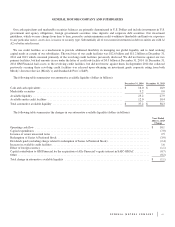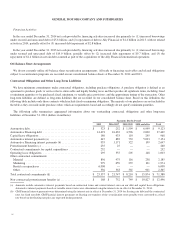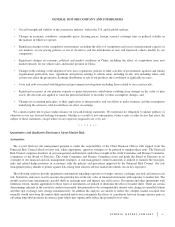General Motors 2014 Annual Report Download - page 59
Download and view the complete annual report
Please find page 59 of the 2014 General Motors annual report below. You can navigate through the pages in the report by either clicking on the pages listed below, or by using the keyword search tool below to find specific information within the annual report.
GENERAL MOTORS COMPANY AND SUBSIDIARIES
• Overall strength and stability of the automotive industry, both in the U.S. and in global markets;
• Changes in economic conditions, commodity prices, housing prices, foreign currency exchange rates or political stability in
the markets in which we operate;
• Significant changes in the competitive environment, including the effect of competition and excess manufacturing capacity in
our markets, on our pricing policies or use of incentives and the introduction of new and improved vehicle models by our
competitors;
• Significant changes in economic, political and market conditions in China, including the effect of competition from new
market entrants, on our vehicle sales and market position in China;
• Changes in the existing, or the adoption of new, laws, regulations, policies or other activities of governments, agencies and similar
organizations particularly laws, regulations and policies relating to vehicle safety including recalls, and, including where such
actions may affect the production, licensing, distribution or sale of our products, the cost thereof or applicable tax rates;
• Costs and risks associated with litigation and government investigations including those related to our recent recalls;
• Significant increases in our pension expense or projected pension contributions resulting from changes in the value of plan
assets, the discount rate applied to value the pension liabilities or mortality or other assumption changes; and
• Changes in accounting principles, or their application or interpretation, and our ability to make estimates and the assumptions
underlying the estimates, which could have an effect on earnings.
We caution readers not to place undue reliance on forward-looking statements. We undertake no obligation to update publicly or
otherwise revise any forward-looking statements, whether as a result of new information, future events or other factors that affect the
subject of these statements, except where we are expressly required to do so by law.
*******
Quantitative and Qualitative Disclosures About Market Risk
Automotive
The overall financial risk management program is under the responsibility of the Chief Financial Officer with support from the
Financial Risk Council which reviews and, where appropriate, approves strategies to be pursued to mitigate these risks. The Financial
Risk Council comprises members of our management and functions under the oversight of the Audit Committee and Finance Committee,
committees of the Board of Directors. The Audit Committee and Finance Committee assist and guide the Board of Directors in its
oversight of our financial and risk management strategies. A risk management control framework is utilized to monitor the strategies,
risks and related hedge positions in accordance with the policies and procedures approved by the Financial Risk Council. Our risk
management policy intends to protect against risk arising from extreme adverse market movements on our key exposures.
The following analyses provide quantitative information regarding exposure to foreign currency exchange rate risk and interest rate
risk. Sensitivity analysis is used to measure the potential loss in the fair value of financial instruments with exposure to market risk. The
models used assume instantaneous, parallel shifts in exchange rates and interest rate yield curves. For options and other instruments with
nonlinear returns, models appropriate to these types of instruments are utilized to determine the effect of market shifts. There are certain
shortcomings inherent in the sensitivity analyses presented, due primarily to the assumption that interest rates change in a parallel fashion
and that spot exchange rates change instantaneously. In addition the analyses are unable to reflect the complex market reactions that
normally would arise from the market shifts modeled and do not contemplate the effects of correlations between foreign currency pairs or
offsetting long-short positions in currency pairs which may significantly reduce the potential loss in value.
59
























